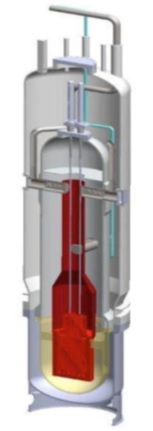Late last week the Department of Energy finally announced its decision to provide the small modular reactor (SMR) design NuScale with a matching grant of up to $226 million under its Licensing Technical Support program intended to speed the development of SMRs.
But the real news is not that DOE awarded a second grant under the program, but that it took so long to do so. NuScale, along with three other reactor vendors, originally applied for the funds in early 2012 with the expectation that two designs would receive grants. However, later that year DOE surprised many observers by only awarding a grant to one design, the Generation mPower.
Subsequently, DOE issued a second solicitation that sought “innovative” designs. But three of the four applicants applicants for the second round were the same designs—including NuScale—that had been denied funding under the first round. In the absence of additional good applicants, DOE’s move to spend the rest of the money on a design it had originally rejected smacks of desperation.
Safety and Security Concerns
As discussed in detail in my September 2013 report “Small Isn’t Always Beautiful,” UCS has safety and security concerns about small modular reactors in general and about the NuScale design in particular. SMR vendors are pushing the Nuclear Regulatory Commission (NRC) to weaken its regulations regarding operator staffing, security staffing, and emergency planning, based on highly optimistic assertions that their reactors will be significantly safer than larger reactors.
NuScale raises issues because of its fundamental design: up to 12 reactor modules packed together in a swimming-pool type structure. The Fukushima disaster has shown the world the complexity of trying to manage multiple nuclear reactor accidents when crisis strikes, and it is far from obvious that the NuScale concept addresses this issue adequately. UCS also does not have confidence that the NRC’s licensing processes will give appropriate weight to multi-unit safety issues. Unfortunately, earlier this month the NRC staff concluded that safety concerns associated with “multiunit core damage events” did not warrant further evaluation in its “Generic Issues” program, which could have resulted in additional regulatory requirements.
Others Agree
Many of the safety concerns described in the UCS report have now been validated by a Powerpoint presentation that was recently included, perhaps inadvertently, in the many thousands of pages of documents that the NRC has released under a Freedom of Information Act request for documents related to the Fukushima accident. The Powerpoint presentation, entitled “Center for Nuclear Waste Regulatory Analyses: Support to the U.S. Nuclear Regulatory Commission Office of New Reactors” (p. 479-529) and dated March 24, 2011, describes safety issues for SMRs such as
- Potential fire and explosion hazards: below-grade facilities present unique challenges, such as smoke/fire behavior; life safety; design and operation of the HVAC system and removal of waste water.
- Potential flooding hazards: below-grade reactors and subsystems raise concerns with regard to hurricane storm surges, tsunami run-up and water infiltration into structures.
- Limited access for conducting inspections of pressure vessels and components that are crucial for containing radiation, such as welds, steam generators, bolted connections and valves.
The document also spells out safety concerns particular to the NuScale design, observing that the reactors and spent fuel are stored in the same structure and depend on the same pool for cooling; that the bioshield covering the reactors or even the reactors themselves could be displaced in a flood; that the cooling pool could become contaminated with debris or other substances during a flood; and that operation under both normal and accident conditions depends highly on proper operation of valves around the pressure vessel.
This document underscores the fact that SMRs are novel designs that raise new safety issues, and much analysis and testing will be required in order to verify the vendors’ safety claims.
There is therefore no basis at the present time for the NRC to grant SMRs any special exemptions to its regulatory requirements, and the Department of Energy should take steps to insure that its Technical Licensing Support program does not use taxpayer funds to endanger public health by undermining nuclear safety and security standards.

